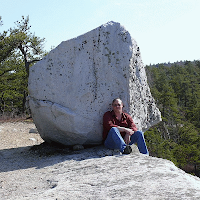Tripod Rock is similar to the North Salem Balanced Rock in northern Westchester County which I've also posted about. In both cases, these are rocks that geologists refer to as glacial erratics but also have claims of being anthropogenic (man-made) structures.
The Visitor's Center was closed when we were there (a weekday in early January) but the bulletin board had a good supply of maps and other information). The hike from the Visitor's Center to Tripod Rock is about three miles round trip on well-marked and maintained trails with about three hundred feet of elevation change to get up to the ridge where the feature is located.
Geologically, Pyramid Mountain is Precambrian gneiss of the New Jersey Highlands (a continuation of our own Hudson Highlands here in the Hudson Valley) just west of the Ramapo Fault boundary with the Newark lowlands. It was easy to see numerous signs of glaciation in the area.
One of many large glacial erratic boulders in the forest
A smaller erratic of Devonian Schunnemunk Conglomerate
Glacial striations in the Precambrian gneiss bedrock
Tripod rock is certainly an impressive feature at the top of a small rise. Approximately 2.5 x 2.5 x 5 meters in size (a very rough guess from my pictures), it would weigh around 100 U.S. tons. It's balanced on three other rocks about a half meter off the ground (hence the name, tripod rock).
Someone placed a large log on the right side that I didn't feel like moving
The geologic story of Tripod Rock is simple enough. During the last advance (Wisconsin) of the most recent Pleistocene Epoch ice age, sheets of glacial ice moved down from the north plucking and carrying boulders which then become deposited as glacial erratics as the ice melted around 12,000 years ago. Tripod Rock, along with the New Salem Balanced Rock in northern Westchester, just happened to be deposited on other rocks leaving them nicely balanced for us to admire today.
That's not the whole story, however. Some have argued that Tripod Rock is a natural solstice marker. Others have gone even further and have called this a dolmen. Is there any chance that this interpretation is correct?
Well, to start, the glacial erratic interpretation is certainly the most plausible (Occam's Razor and all that). As mentioned above, the area was clearly glaciated and even the bedrock on which Tripod Rock rests shows glacial polishing, striations, and chatter marks (a row of crescent-shaped chips carved out by rocks carried along the bottom of a glacier).
Claims have been made for a summer solstice alignment at Tripod Rock (Scofield, B. 1983. A possible summer solstice marker in northern New Jersey. NEARA Journal 18:4-27). Here's a diagram of the alignment from Wikipedia.
I'm a bit unconvinced. I could draw a lot of different lines on the above diagram and odds are that one or the other will align with something celestial.
Get the idea?
Boulders labeled G & H in the diagram. Also partly balanced.
Was this a dolmen? Did the Lenape Native Americans or some other people build this? While not impossible, it seems unlikely only because there's simply no evidence to suggest that they did other than "Wow, that's neat, it's unusual so someone must have created it." That doesn't mean it wasn't used as a solstice marker by Native Americans, just that until I see some sort of credible evidence, I remain skeptical.
Snipped from a website. This is just crazy talk!













Great rock! Here in NE TN we have some interesting rocks too
ReplyDelete